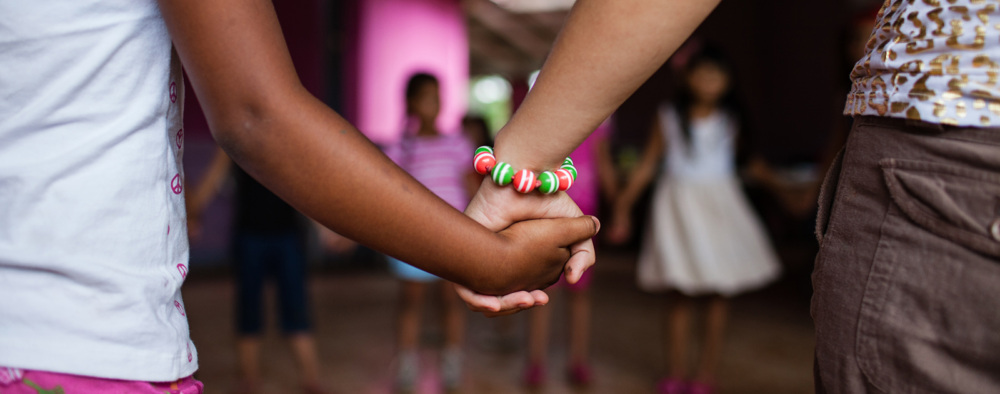
Segurança e bem-estar
Segurança e bem-estar
Hora da confissão. Adiei a escrita deste artigo por um tempo.
Por mais de dois anos, a GFC tem trabalhado arduamente para estabelecer normas, protocolos e mudanças culturais em apoio a proteção da criança – nosso compromisso em defender e proteger os direitos da criança.
Colegas e amigos da GFC frequentemente comentam que a maneira como atendemos nossos parceiros neste espaço é única, e eles querem saber mais sobre como fazemos isso. Eu sabia que era hora de reservar um momento para refletir sobre o que aprendemos.
Mas então a epidemia do coronavírus tomou conta.
Dada a atual crise global em que vivemos, não senti que era o momento certo para escrever esta reflexão. Quem se importa com o que uma organização passou em salvaguarda quando o mundo parece opressor e confuso? Estamos todos apenas tentando sobreviver agora e passar pela rotina diária.
No entanto, a realidade é que operar dentro de uma cultura e estrutura de proteção nunca foi tão relevante e importante.
Quando a visão do mundo muda para algo sem precedentes, aqueles que são vulneráveis se veem ainda mais isolados da ajuda.
As crianças são forçadas a ficar em casa com os perpetradores de seu abuso doméstico. Mulheres e meninas não conseguem acessar kits de higiene e santuário. Tensões tensas em casa – causadas pelo desemprego e preocupações sobre como sustentar a família – começam a afetar os pais. A pressão sobre as organizações para encontrar maneiras inovadoras de manter seus usuários de serviços seguros, enquanto operam em meio a bloqueios e regras de distanciamento social, é monumental.
[image_caption caption=”Os parceiros do GFC atendem jovens que já vivem em circunstâncias vulneráveis e estão relatando riscos aumentados para crianças devido ao coronavírus. Aqui, a Sahyog Care for You distribui desinfetante para mãos para crianças que vivem em comunidades de favelas em Nova Déli, Índia. © Sahyog Care for You” float=””]

[/imagem_legenda]
Para isso, eu e a equipe de proteção gostaríamos de compartilhar o que aprendemos nos últimos dois anos sobre a mobilização de uma abordagem de proteção para organizações de base, caso isso ajude sua organização, especialmente nestes tempos tão desafiadores e incertos.
Estamos em uma jornada, sabemos disso. E gostaríamos de conversar sobre nosso aprendizado com você à medida que avançamos. Entre em contato com nossa equipe em salvaguarda@globalfundforchildren.org Se você tiver dúvidas, sugestões ou comentários gerais – um mundo verdadeiramente seguro só pode ser alcançado quando as organizações trabalham juntas.
Em 2019, pela primeira vez, a GFC exigiu que todos os seus parceiros concordassem em desenvolver uma política de salvaguarda como uma contingência para receber fundos. Quando a GFC comunicou esse requisito aos parceiros pela primeira vez, eles estavam receptivos e ansiosos para se envolver em conversas significativas sobre esse tópico.
Nossos parceiros são organizações corajosas que realmente se importam com as crianças e os jovens que atendem. Esse requisito não era apenas uma caixa para marcar para que pudessem ter acesso ao financiamento. Os parceiros buscaram ativamente o conselho da equipe do GFC para escrever suas políticas e responder a incidentes de proteção. Eles solicitaram ativamente sessões sobre proteção em reuniões. Eles ofereceram suas próprias políticas para serem compartilhadas com seus pares como exemplos. E eles investiram dinheiro na contratação de advogados e facilitadores para escrever suas políticas e treinar sua equipe.
Não duvidamos da preocupação dos nossos parceiros com as crianças sob seus cuidados, mas o entusiasmo deles por esse processo nos motivou a todos.
Conversas sobre políticas de proteção infantil se tornaram mais frequentes no âmbito das ONGs internacionais, mas as conversas são dominadas por grandes organizações. É menos comum ouvir sobre proteção no contexto de organizações locais pequenas, nascentes e lideradas por jovens, como aquelas com as quais a GFC faz parceria.
As implicações para esses tipos de organizações são diferentes. Nós nos esforçamos para permitir que nossos parceiros tenham flexibilidade para criar uma política de proteção que funcione para seu contexto individual, cultura, sistemas legais e comunidade, mas aprendemos que ter requisitos mínimos de política – como sistemas de relatórios, ter uma pessoa designada responsável pela proteção e um plano de ação se houver um incidente – pode ajudar a orientar as organizações.
Escrever uma política completa e clara, treinar suficientemente a equipe e mudar a cultura organizacional não acontece da noite para o dia. Para muitos dos nossos parceiros, encontrar o equilíbrio entre investir tempo e recursos limitados e querer servir melhor seus participantes era difícil.
Para ajudar com essa questão, a GFC forneceu a vários parceiros Subsídios de Desenvolvimento Organizacional, que eles usaram para investir na redação de suas políticas de proteção e no treinamento de sua equipe. Esses parceiros agora se tornaram líderes de pensamento em suas próprias comunidades, com outras organizações comunitárias pedindo a eles orientação em proteção. Também facilitamos sessões sobre proteção em convenções e distribuímos aos nossos parceiros uma lista de recursos de proteção selecionados em inglês e espanhol.
A confiança entre nossos parceiros e a GFC é crucial para um engajamento conjunto significativo na proteção. A confiança entre a equipe é essencial para trabalhar em desafios e novas estratégias.
Confiança é saber que você pode ser honesto sobre onde a política parece confusa ou difícil de manter. À medida que aprendemos por meio deste espaço juntos, se tivermos confiança de que estamos todos trabalhando para criar espaços seguros para crianças, jovens e comunidades e podemos pedir uns aos outros por ajuda, orientação e apoio, o resultado final será vidas mais seguras para aqueles que buscamos servir.
E isso é tudo o que todos nós realmente queremos, não é?
Foto do cabeçalho: © Kuba Okon / With and For Girls Collective
